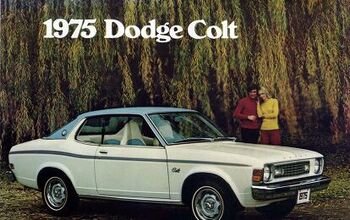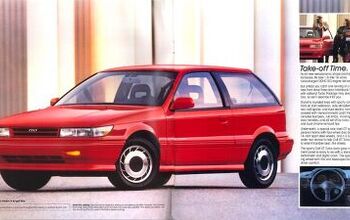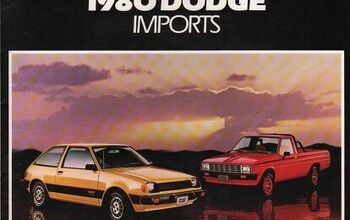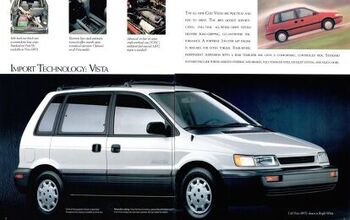Abandoned History: Chrysler and the Colt, Captive Economical Import Time (Part VII)

We arrive at the end of our Dodge Colt journey today. Colt started in 1971 as a cooperative program to provide Mitsubishi with a sales outlet in North America, and Chrysler with a compact and fuel-efficient car it didn’t have to design or build. Over the years the Colt evolved with the needs of the consumer and branched out into several different body styles.
Eventually, the tides shifted. Mitsubishi established their own dealerships in the United States (but not Canada) and started selling identical cars as were on Dodge/Plymouth dealer lots. Then, as Eagle came into being it also needed product to sell. Chrysler turned Eagle into its de facto outlet for imports and Mitsubishi cooperative products: Colts of regular and wagon persuasion became Eagles called Vista and Summit, in addition to their Dodge and Plymouth twins.
Last time we left our tale it was the dawn of 1993, and Colts were badged at Eagle dealers as a new generation of Summit. The Vista Wagon name was dead, now called Summit Wagon. Dodge, Plymouth, and Eagle dealers had an exciting new Colt as well! But it didn’t last long.
The seventh-generation Dodge Colt and company were badge reworks of the fourth-generation Mitsubishi Mirage (or Colt, Lancer, or Libero) as they were in past generations. The fourth-generation Mirage grew much more modern looking, and in some versions mimicked Peugeot styling a bit. Mirage entered production in October of 1991 for the 1992 model year. In most markets, it was available in several different body styles. The smallest was two doors like a coupe or three doors as a capacious hatchback. There were also two different sedans (oddly): The sportier sedan had four side windows, while the more formal one had six.
Like before, the Mirage was front-wheel drive with optional four-wheel drive (in Mitsubishi’s tradition of making very capable small vehicles.) Engines varied by market and ranged from a tiny naturally aspirated 1.3-liter inline-four through a 2.0-liter turbocharged inline-four. There were also a couple of turbodiesel engines. Transmissions varied from a lethargic three-speed automatic to a four-speed auto, as well as four- and five-speed manuals. Colts and Colt-Summit sedans and coupes in North America were front-drive only.
Mitsubishi offered two wheelbases on the Mirage, the same strategy it used with the Expo and Expo LRV. The Mirage wagon was branded separately as the Libero, to separate it from Mirage heritage. Libero was sold only in the Japanese market and was introduced a year after the other body styles. A standalone, the wagon was long-lived and a popular vehicle: It existed in its 1992 format through 2012 in Japan.
There were numerous production locations for the Mirage, which remained in its fourth generation guise from 1991 through 1995. Primary Japanese production in Okazaki was supplemented by factories in New Zealand, the Philippines, Taiwan, Thailand, Indonesia, and even in the United States. Colts and Summits for North America were built at the DSM factory in Normal, Illinois alongside the Eclipse, Talon, and the like.
At Dodge, Plymouth, and Eagle dealers, the new seventh-gen Summit was a bit of a divergence from its prior self. While the Colt had long been available as a sedan or hatchback (and sometimes a wagon), its new 1993 guise saw it available as a sporty two-door coupe, or more sedate four-door sedan. It was the six-window sedan version, the four-window was not imported to North America.
There were two engine options in 1993, a 1.5-liter 4G15, or a 1.8-liter 4G93. The 1.5 was a carryover from the prior generation and was a part of the Astron engine series that debuted in the Colt in 1977. The 4G93 mill was a newer design, with 16 valves, dual overhead cams, and fuel injection. Buyers of the base 1.5 had 92 horsepower at their right foot, while the 1.8-liter offered 113. Three- and four-speed automatics were offered in North America, but the only manual available was the five-speed.
For its debut year in 1993, the only way to get the 1.8-liter engine was with four doors. In contrast, the sporty ES trim was eliminated from the Colt sedan but was brought back for the coupe. It arrived in 1994 and was the only way to order the 1.8-liter engine in a two-door Colt.
Colt grew quite a bit larger in its seventh generation. Wheelbase increased from a uniform 93.9 inches in the outgoing generation, into the aforementioned two-wheelbase setup. New Colts in two-door form had a 96.1-inch wheelbase. As a sedan, the wheelbase stretched to 98.4 inches. In other markets, the coupe and hatchback were on the shorter wheelbase, while sedan and wagon were the longest.
Overall length increased considerably as Colt grew more modern: The tidy 158.7-inch measurement of 1992’s Colt sedan grew to 174 inches in 1993. Likewise, the coupe was a larger car at 171 inches. The width increased from 65.5 inches to 66.1. Curiously, the ES trim of the new Colt was a bit wider, at 66.5 inches because of its body kit. Height decreased marginally in the seventh generation, from 52 inches down to 51.4 inches on the sedan, and 51.6 inches for the coupe.
Stylistically, the new Colt had little in common with its predecessor. Mitsubishi directed the Mirage away from its prior Galant-like styling and went for a shape all its own. Headlamps were more aerodynamic and were paired with wraparound corner markers. The grille was almost nonexistent on the new version, relegated to a thin slat under the hood. The front end looks diverged for the first time, as the coupe was a bit more aero-focused and aggressive than the sedan.
The exterior of both versions was more curvaceous than before and featured limited trim that was body-colored instead of black. Overall, the look was very early-mid Nineties econobox, with every corner and detail rounded or oval-shaped. The rear ends of both body styles were much more swept back than before and lacked the “small upright sedan” look of the outgoing Colt. Though the Colt/Summit sedan and coupe were sold alongside the Colt Vista / Summit Wagon at dealers, they had little to do with one another, looked completely different, and were available only in front-wheel drive.
And this is where the story of the Colt concludes. The final generation Colts and Summits were an exercise to buy time until the main event happened: Neon. At the end of the 1994 model year, the standard Colts were quickly dismissed from all dealers, as Neons started to arrive for ’95. The Neon was more modern, better looking, fit into Chrysler’s styling, and was much more appealing to the average compact-car customer.
The Neon was marketed as cool, fresh, and young, and said marketing absolutely worked. Dodge and Plymouth dealers received the same Neon with different trims (remember Expresso?). The Dodge Colt Vista and Plymouth Vista continued on sale at their respective outlets through 1996, a little remainder of the Colt name.
Interestingly, Eagle dealers continued in their full-on Colt love a bit longer: All three Summit versions remained on sale through 1996. One must wonder if there was any consideration given to an Eagle version of the Neon; perhaps call it the Hatchling. In Summit world, for 1995 a passenger-side airbag was added to all Summit models to supplement the driver’s side bag that arrived in 1994. ES trims were renamed to ESi. Unlike Colts, the Summit was available in ES/ESi trim on both the sedan and coupe. After 1996, the smallest thing Eagle offered was the Talon.
The 1996 Summit lineup was truly the epitome of Colt. They had the most safety features, the nicest trim, and the most modern styling. Prices that final year ranged from $10,625 ($19,523 adj.) for a DL coupe to $11,689 ($21,478 adj.) for an ESi Coupe. The sedan started in LX trim at $13,072 ($24,020 adj.), and was $12,869 ($23,647 adj.) as an ESi. Summit Wagon was sold as DL for $15,034 ($27,625 adj.), LX at $16,272 ($29,900 adj.), and in AWD trim at $16,909 ($31,070 adj.). Funny, that $637 difference ($1,170 adj.) is a bit less than the $2,000+ charged in a modern crossover for all-wheel drive.
And so it was that 1996 were the last traces of Colt in North America. Over on Mitsubishi lots (still not in Canada), a new Mirage arrived for 1997 that was a size class up as it graduated from subcompact to compact. A couple of years later Mitsubishi would sever ties with the Colt branding permanently when it changed the Mirage name out for a much more successful one: Lancer.
[Images: Chrysler]

Interested in lots of cars and their various historical contexts. Started writing articles for TTAC in late 2016, when my first posts were QOTDs. From there I started a few new series like Rare Rides, Buy/Drive/Burn, Abandoned History, and most recently Rare Rides Icons. Operating from a home base in Cincinnati, Ohio, a relative auto journalist dead zone. Many of my articles are prompted by something I'll see on social media that sparks my interest and causes me to research. Finding articles and information from the early days of the internet and beyond that covers the little details lost to time: trim packages, color and wheel choices, interior fabrics. Beyond those, I'm fascinated by automotive industry experiments, both failures and successes. Lately I've taken an interest in AI, and generating "what if" type images for car models long dead. Reincarnating a modern Toyota Paseo, Lincoln Mark IX, or Isuzu Trooper through a text prompt is fun. Fun to post them on Twitter too, and watch people overreact. To that end, the social media I use most is Twitter, @CoreyLewis86. I also contribute pieces for Forbes Wheels and Forbes Home.
More by Corey Lewis
Latest Car Reviews
Read moreLatest Product Reviews
Read moreRecent Comments
- EBFlex It’s ironic that the typical low IQ big government simps are all over this yet we’re completely silent when oil companies took massive losses during Covid. Funny how that’s fine but profits aren’t. These people have no idea how business works.
- Ajla Goldman Sachs 🥂
- Rna65689660 DVR and watch all that are aired. Has been this way for 40 years.
- Kwik_Shift_Pro4X The only car racing I'll watch is rally car.
- Offbeat Oddity The price is definitely too high, but this generation of Accord has still been very reliable- not far off from the Camry. I believe the CVTs in these have held up very well, so while not ideal, it wouldn't deter me- the mileage is just way too high.









































Comments
Join the conversation
Its hilarious to me to see the "affordable" Shadow POS and the "luxury" Dy-nasty opposite the all new for the 90s (and direct from Japan) Colt. Given I lived through the time period, I do understand how that lineup happened and likely worked instead of being laughed at as I am now, but its akin to putting a Pinto aside from Bronco Escape.
How about covering Asuna some time?